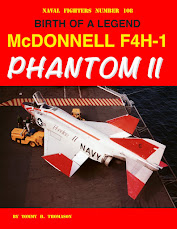In the meantime, the Navy had to repaint airplanes that had already been delivered and for a time, those being delivered. It appears that a goodly number of these repaints were done at Norfolk, Virginia to a standardized and somewhat different scheme than the ones that the manufacturers would come up with. It is characterized by the Sea Blue upper surface color extending almost straight down on the side of the fuselage to the leading and trailing edges of the wing and relatively less Sea Blue on the side of the fuselage than the eventual production schemes. In this example, the TBM? on the left has the factory paint scheme and the TBF? on the right is the Norfolk scheme.
Click HERE for my prior discussion of it and more examples.
ASW Schemes I and II were implemented by the Commander Aircraft, Atlantic in July 1943 but not covered by a Navy specification until June 1944. In a recent discussion on one of the modeling websites of these schemes, I began to wonder if I hadn't mistaken at least one picture of an aircraft with an ASW scheme for an example of what I term the Norfolk scheme.
ASW Scheme I: For use in areas where the prevailing weather was clear or clear with broken clouds (the southern United States seaboard, Gulf of Mexico, Caribbean, and South America). This was a topside of nonspecular Dark Gull Gray, sides of nonspecular Light Gull Gray, and bottom of Gloss White. The side surfaces in the shadow of the wings and horizontal tail were to be painted nonspecular Insignia White. In a gray-scale picture, it looks very much like the blue tri-color scheme.
ASW Scheme II: For use in areas where the prevailing weather was overcast of heavily clouded (the middle and northern United States seaboard and the North Atlantic). This was a topside of nonspecular Dark Gull Gray, sides of nonspecular Insignia White, and bottom of Gloss White. The difference between it and Scheme I was the use of White rather than Light Gull Gray on the sides.
In both Scheme I and II, the leading edge and inside of the cowlings, propeller domes, and propeller blades (out to the inner edge of the cowling opening) were to be painted nonspecular Insignia White.
However, the examples are somewhat confusing. This is a picture of SBDs from VMS-3, which was based in the Virgin Islands (rough duty).
It would seem that these airplanes should be in Scheme I (Light Gull Gray on the sides) since they're based in the South Atlantic. Instead, the sides appear to be white, which is Scheme II. One theory for this discrepancy is that the anticipated basing of the airplanes was not the same as their actual assignment. Note that the extension of the top color directly down to the wings is very similar to the Norfolk scheme in this example as well as the two that follow.
This is an example of Scheme II provided by Steven (Modeldad) Eisenman:
The white sides are pretty unmistakeable.
This is an example of Scheme I (Light Gull Gray sides) provided by Steven:
Note the white propeller dome in both cases as well as the early rocket launchers; a hole made by a rocket was an effective way to keep a surfaced submarine from submerging to the relative safety of the depths.
The picture that got my attention was this one:
It was also cited as an example of the ASW Scheme I. However, based on the fact that it has a circle and star national insignia, (and does not have the white-painted propeller dome and inner blades) my guess is that it's an example of the Norfolk tri-color scheme, since the start of the transition to the star and bar insignia predated the multi-color ASW schemes:









No comments:
Post a Comment